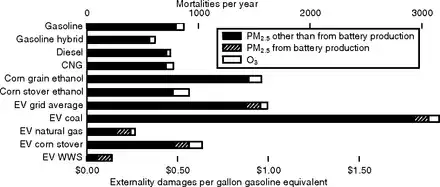Battery Weight
Batteries are heavy
- a Tesla 85kWh battery weighs 540kg.
- VW Golf 55.7kWh battery weight 330kg
you are looking at around 6kg per kWh.
The flanderstoday.eu article above says 'Those so-called non-exhaust emissions are higher in electric cars because most of them are heavier than other kinds of cars' so, I think a large part of this claim is based on how much heavier an EV is and how much more shedding of the components and road will occur due to that additional weight so it is first important to determine how much heavier an electric car is compared to a petrol car.
How much heavier are electric cars?
I compared vehicles that had an electric version and a non electric version of the same model. This is so that we can compare the differences in weight in cars that are the same in terms of size and componentry, except for the difference of being electric and being non electric. We don't want to compare a Tesla ModelX to a Smart ForTwo petrol car!
Medium cars
The 235 mile Kia e-Niro 64 kWh is a good fit for comparison - it weighs 1,812kg and the petrol versions are somewhere between 1,490kg & 1,594kg depending on model. So here the electric version would be 12% - 18% heavier.
The additional weight is just the extra weight of the battery; electric components weigh less and they are simpler (no clutch, combustion engines are heavy and related to engine size).
For small cars
The Smart EQ 79 mile range ForTwo coupe with 17.2kWh battery weighs 1,095kg. The older ForTwo petrol version weighed 880kg. So the electric version would be about 20% heavier. If it was possible to have a battery with a range of 235m you would need another battery of
((17.2kWh / 79m) x 235m) - 17.2kWh = 54kWh battery
which would weigh another 203kg. That would mean the small car would be 33% heavier at the same range as the Kia.
Weight in electric vehicles also compares strongly with range, the longer the range the bigger the battery the extra size. These are difficult comparisons but it seems like you could say electric vehicles are somewhere between 10 and 30% heavier for electric cars. It is also obvious that some vehicles are unnecessarily heavy.
Other benefits of Electric Cars regarding particulate emissions
Electric cars will have much less brake pad wear because they will have regenertive brakes. Brake pad wear can normally account for 30% (ish) of the particulate emissions from cars (although drum brakes would also reduce the amount of brake pad particulates and the car wouldn't need to be electric).
Electric vehicles have smoother acceleration so may not wear the tyres so much but...due to the extra torque in an electric motor, maybe there is no difference (please correct me here!). Also electric vehicles won't have a clutch which could add a little to wear.
Conclusion
If the amount of tyre and road particulate matter generated is proportional to the extra weight then I think generally there isn't going to be much difference in particulate emissions, especially if you factor in the regenerative breaking savings. However, battery weight needs to be factored in and the larger the battery the more particulates generated from tyre and road wear.
Other improvements
There are few regulations on materials and particulate emissions for brake pads, tyres, clutches and how roads are made and maintained. Also there are few reliable studies and many variables (a wet country wouldn't have so much redistribution of particulates as a dry country). Also, how do you compare? Do you compare a car with or without drum brakes.
I think the real problem is unnecessarily heavy cars, poor traffic management with many stop starts in a journey, poor regulations on compositions of tyres and other componentry and better driving behaviour that reduces unnecessary acceleration and braking. Electric vehicles have obvious other benefits like zero particulates from the exhaust, zero NO2 from the exhaust, much less CO2 emissions (50% including manufacture??? if using mostly renewables), they have longer lives too.
Longer ranges from EVs could also be gained from battery swap stations similar to those in China so that large heavy batteries are used less often or are only swapped in on longer journeys.
https://publications.jrc.ec.europa.eu/repository/bitstream/JRC89231/jrc89231-online%20final%20version%202.pdf
https://uk-air.defra.gov.uk/assets/documents/reports/cat09/1907101151_20190709_Non_Exhaust_Emissions_typeset_Final.pdf
